A Guide to Lovebird Care: Love Birds Food, Treats and More!
Today we'll cover everything from diet and housing to toys and lovebird care. So if you're thinking about getting love birds as a pet, then this blog is for you.
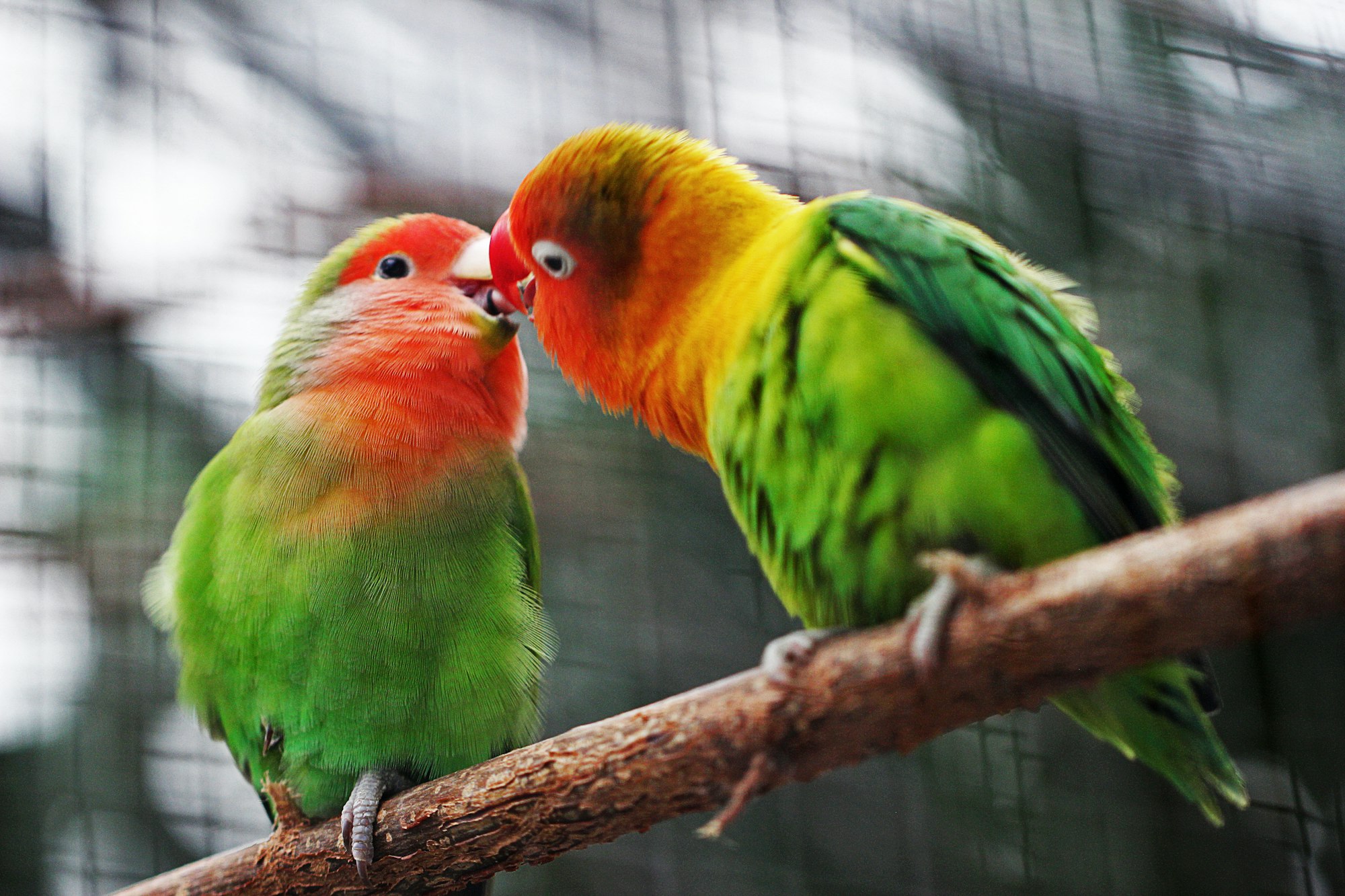
Key Takeaways:
- Lovebirds require a varied diet to stay healthy, including fresh fruits, vegetables, and formulated diets.
- Proper food and water dishes are essential for maintaining a clean and healthy environment for your lovebirds.
- Regular consultation with an avian veterinarian ensures that your lovebird's diet meets all their nutritional needs.
Introduction
Lovebirds are charming, vibrant, and full of personality. As pet owners, we continually strive to provide the best care for these delightful creatures. There are nine species of lovebirds, each with different characteristics, so understanding the different species is important for proper care. The average life span of a lovebird is 10-12 years, though some may live longer with proper care. One of the most critical aspects of lovebird care is their diet. A proper diet ensures that lovebirds stay healthy, active, and happy. This guide will delve into the essentials of lovebird care, focusing on their food, treats, and more.
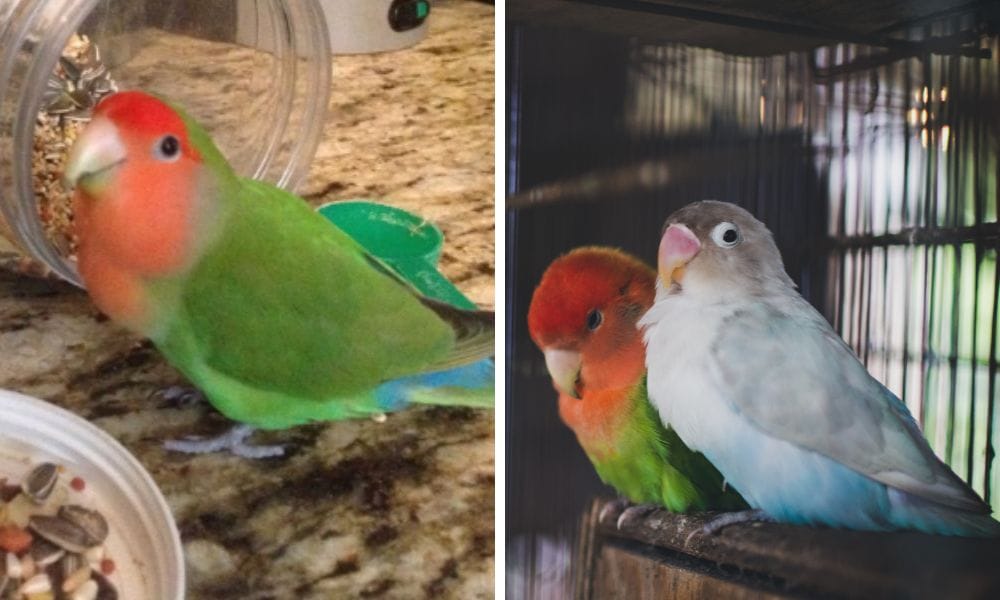
Introduction to Pet Birds
Welcoming a new pet bird into your home is an exciting step in your journey of bird ownership. Lovebirds, with their vibrant plumage and lively personalities, make wonderful companions for both first-time and experienced bird enthusiasts. These small parrots are known for their affectionate nature and strong social bonds, often forming close relationships with their owners and other birds. To ensure your lovebird thrives, it’s important to understand their unique needs, from providing a stimulating environment to offering a nutritious diet and plenty of social interaction. By learning the basics of lovebird care, you’ll be well on your way to building a rewarding and lasting relationship with your feathered friend.
Choosing a Lovebird Species
With nine species of lovebirds available, choosing the right one for your home can feel overwhelming. Each lovebird species has its own distinct personality, coloration, and care requirements. For example, the peach faced lovebird is famous for its playful and affectionate demeanor, making it a favorite among families and singles alike. Fischer’s lovebirds, on the other hand, are admired for their striking green and yellow feathers and their energetic, social nature. When selecting a lovebird, consider factors such as temperament, activity level, and compatibility with other birds or pets in your household. It’s also wise to research the specific dietary and environmental needs of your chosen species. Consulting with an avian veterinarian or a reputable breeder can provide valuable insights and help you make an informed decision, ensuring you find the perfect lovebird species to match your lifestyle and expectations.
Setting Up a Suitable Environment
Creating a comfortable and stimulating environment is key to successful bird ownership, especially when caring for lovebirds. As social birds, lovebirds thrive in pairs and need a cage spacious enough to allow for plenty of movement, wing stretching, and exercise. A minimum cage size of 32″ x 20″ x 20″ is recommended for a pair, ensuring they have room to fly and play. Where lovebirds live, it is essential to create a safe and comfortable habitat with stable conditions and ample space to promote their health and longevity. Inside the cage, provide about four birds perch options, such as natural tree branches at different heights, to encourage climbing and resting.
In addition to sturdy food and water dishes, consider adding a flat earthenware dish for bathing and a separate dish for greens and vegetable supplements. These additions not only support a balanced diet but also enrich your lovebirds’ daily routine. Including a nesting box or a cozy retreat gives your birds a safe space to hide or rest, which is especially important if they feel threatened or need privacy. By thoughtfully arranging their environment with a variety of perches, a nesting box, and fresh greens, you’ll help your lovebirds feel secure, engaged, and healthy.
Understanding Lovebird's Diet
A lovebird’s diet should be as varied as possible to mimic what they would eat in the wild. Understanding a bird’s diet is crucial, and this includes a mix of seeds, fresh fruits, vegetables, and formulated diets. A proper lovebird diet is a comprehensive plan that ensures nutrition, proper portion control, and a variety of foods for optimal health and happiness. While seeds like sunflower seeds are a favorite, they should not be the only food item in their diet due to their very little nutritional value. Instead, a balanced diet that includes pelleted foods and fresh foods is ideal.
Lovebirds feed throughout the day, so it is important to establish a consistent feeding routine with appropriate dishes to encourage healthy eating habits and ensure they receive all necessary nutrients.
Pelleted diets are formulated to provide all the necessary nutrients that lovebirds need. These diets are designed to enhance the bird’s nutritional health and are often recommended by avian veterinarians. A diet consisting of seeds, pellets, fruit supplements, and fresh vegetables ensures a well-rounded intake of nutrients and supports overall well-being. Fresh foods, such as fruits and vegetables, should also be included in their diet to provide additional vitamins and minerals.
When offering fresh foods, fruit supplements and garden herbs play an important role in providing extra nutrients and variety. Fresh vegetables are a key component, along with fruits and herbs, to support a healthy and balanced diet for your lovebird.
Food and Water Dishes
Choosing the right food and water dishes is crucial for maintaining a clean and healthy environment for your lovebirds. Each food dish should be easy to clean and sturdy enough to withstand the bird’s activity. Stainless steel or ceramic dishes are often recommended as they are durable and easy to sanitize.
Water dishes should be changed daily to ensure fresh water is always available. Establishing a bird daily routine for cleaning and care, including changing water and cleaning dishes, is important to promote your lovebird's health and encourage tame behavior. Lovebirds can be messy eaters, so it’s essential to keep their food and water dishes clean to prevent the growth of bacteria and mold. Remove uneaten food from the dishes daily to prevent spoilage and maintain hygiene. Separate dishes for food and water help maintain hygiene and prevent contamination.
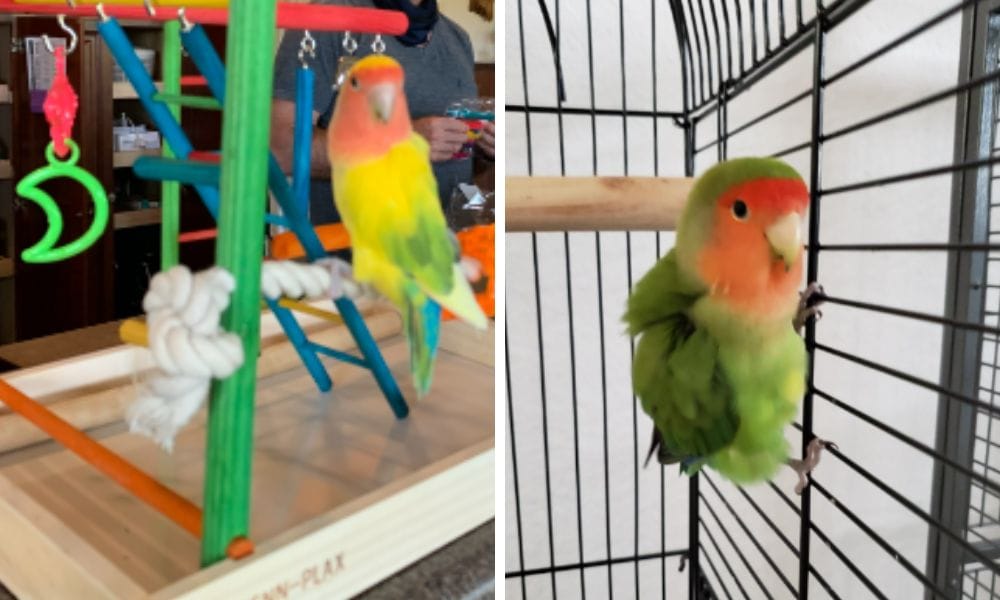
Converting Seed-Eating Birds
Many lovebirds are initially seed eaters, but seeds alone do not provide a balanced diet. Converting seed-eating birds to a more nutritious, formulated diet can be challenging but is essential for their health. Start by gradually mixing pelleted foods with their seeds, slowly increasing the amount of pellets over time. Using a small parrot mix as a transitional option can also help encourage acceptance of new foods.
Offering fresh fruits and vegetables can also help in the transition. Lovebirds are curious by nature, and they may be more willing to try new foods if they see their owners eating them. Hand raised youngsters and young birds are often easier to convert as they are more accustomed to human interaction, new experiences, and are more adaptable.
To begin hand taming young lovebirds, start with gentle, slow movements and speak softly to build trust. Taming involves acceptance, patience, and consistent positive interaction, helping the bird feel safe and comfortable. Gradually coax the bird onto your finger or a dowel, allowing it to become familiar with your presence. With regular social interaction and training, lovebirds can learn to imitate behaviors, making them affectionate and responsive companions.
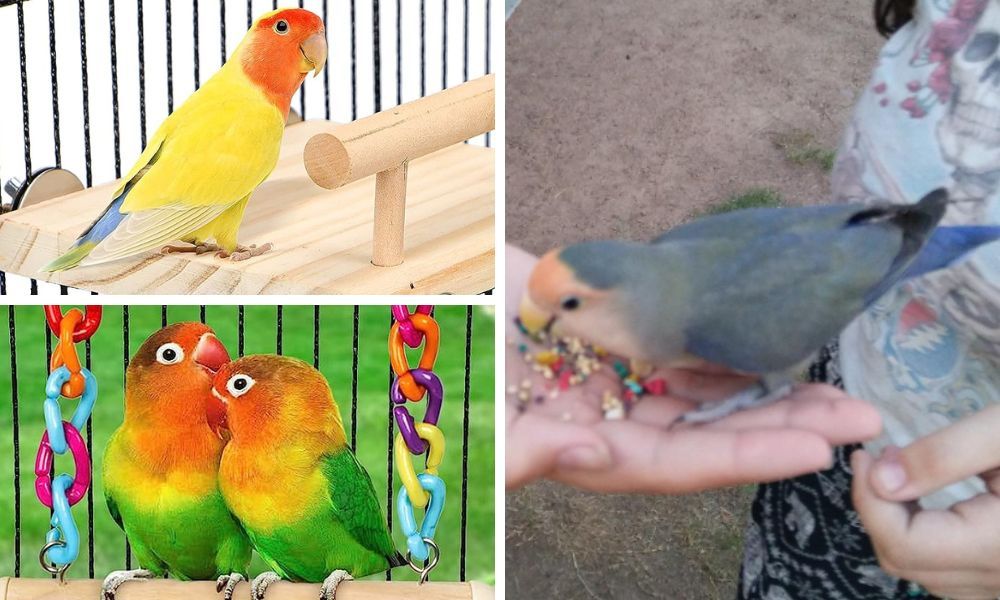
Fresh Foods and Treats
Fresh food is a vital part of a lovebird’s diet. Most lovebirds enjoy a wide variety of fresh fruits, vegetables, and treats as part of their daily diet. Fresh fruits like apples, berries, and melons, and vegetables such as carrots, spinach, and bell peppers provide essential vitamins and minerals. These foods should be washed thoroughly and cut into small, manageable pieces. In addition to fruits and vegetables, you can also offer various garden herbs, brazil nuts, and leaf buds as nutritious treat options for lovebirds.
Treats like millet spray and honey sticks can be given occasionally but should not replace their regular diet. These treats are high in sugar and fat and can lead to poor nutrition if overfed. It’s essential to offer a variety of fresh foods to ensure a well-rounded diet.
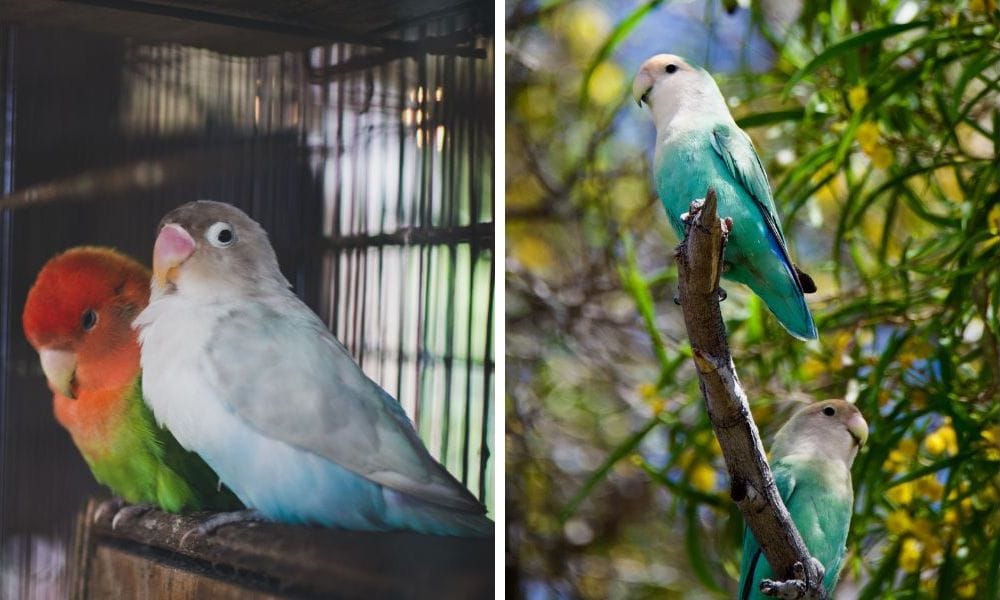
Commercial Seed Mixes
Commercial seed mixes are a common choice for many lovebird owners. However, these mixes often contain seeds with very little nutritional value. Some commercial mixes also include seeds from agricultural crops such as corn and maize, reflecting the natural diet of lovebirds. While they can be part of the diet, they should not be the primary food source. Mixing seeds with pelleted foods and fresh foods can help provide a more balanced diet.
Different formulations of seed mixes are available for different life stages of lovebirds. For example, conditioning foods are designed for molting birds, while breeding mixes are formulated for lovebirds laying eggs. It’s essential to choose the right mix for your bird’s specific needs. The dietary requirements of lovebirds can differ from those of other species of small parrots, so understanding these differences is important to ensure your lovebird receives the proper nutrition.
Nutritional Supplements
Nutritional supplements can be beneficial for lovebirds, especially if their diet lacks certain vitamins and minerals. Calcium supplementation is crucial for breeding females to prevent egg binding. One common way to supplement calcium is by providing oyster shell, which serves as an excellent source of calcium for lovebirds. It is important to supplement calcium to maintain strong bones, beaks, nails, and feathers, and to support overall health. Powdered supplements can be sprinkled on fresh foods, mixed with water, or administered on moist food to encourage intake, particularly when transitioning birds from an all-seed diet to pellets.
However, it’s essential to consult with an avian veterinarian before adding supplements to your bird’s diet. Over-supplementation can lead to health problems, so it’s crucial to find the proper balance. Regular check-ups with a vet can help ensure that your lovebird’s diet meets all their nutritional needs.
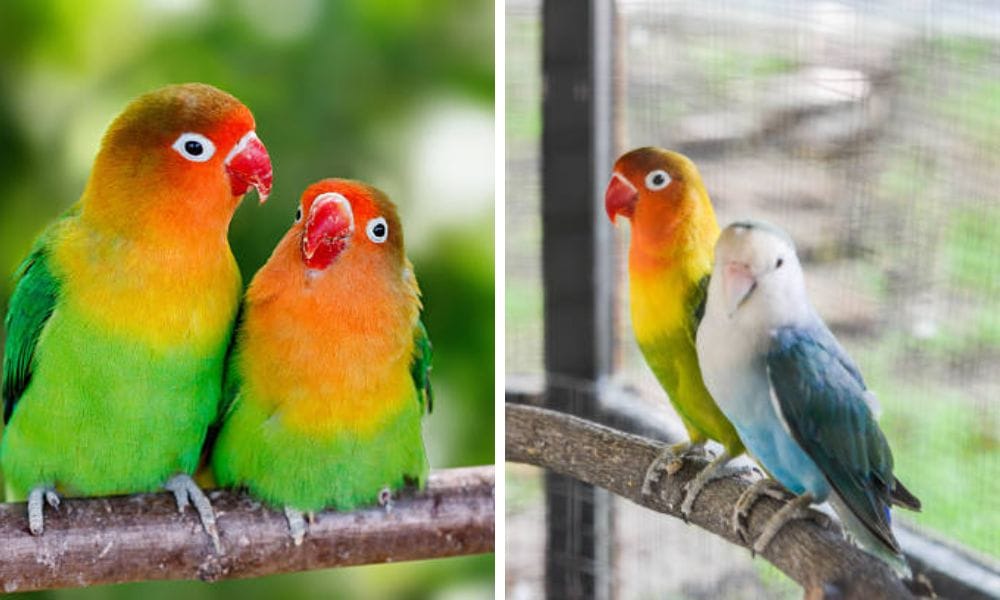
Foods to Avoid
Certain foods can be toxic to lovebirds and should be avoided. Avocado, chocolate, caffeine, and alcoholic beverages are all potentially toxic and can cause severe health issues. Additionally, pale vegetables like iceberg lettuce have very little nutritional value and should not be part of their diet.
It’s also essential to avoid feeding lovebirds junk food or foods high in sugar and fat. Instead, focus on providing wholesome, nutritious food to ensure a balanced diet. These foods can lead to obesity and other health problems. Poor diet can also contribute to diseases such as psittacine beak (including Psittacine Beak and Feather Disease) and intestinal influenza, making proper nutrition crucial for preventing these illnesses. Always use common sense when choosing foods for your lovebird and consult with an avian veterinarian if you have any doubts.
Feeding Different Life Stages
Lovebirds, like any pet bird, have different nutritional needs at various life stages. Young lovebirds, for example, require a diet high in protein and calcium to support their growth. Hand-raised babies may need to be fed more frequently and with specific foods designed for their development.
Mature lovebirds, on the other hand, may require a diet lower in fat to prevent obesity. When breeding lovebirds, ensure that both birds have reached breeding age before pairing them. During the breeding season, their nutritional needs increase, so provide extra vitamins and minerals to support egg production and chick health. It is also important to place appropriate nest boxes in the cage or aviary, as nest boxes are essential for breeding and nesting, providing a secure and comfortable space for lovebirds to lay eggs and raise chicks. Adjust their diet according to their life stage to ensure they receive the proper nutrients.
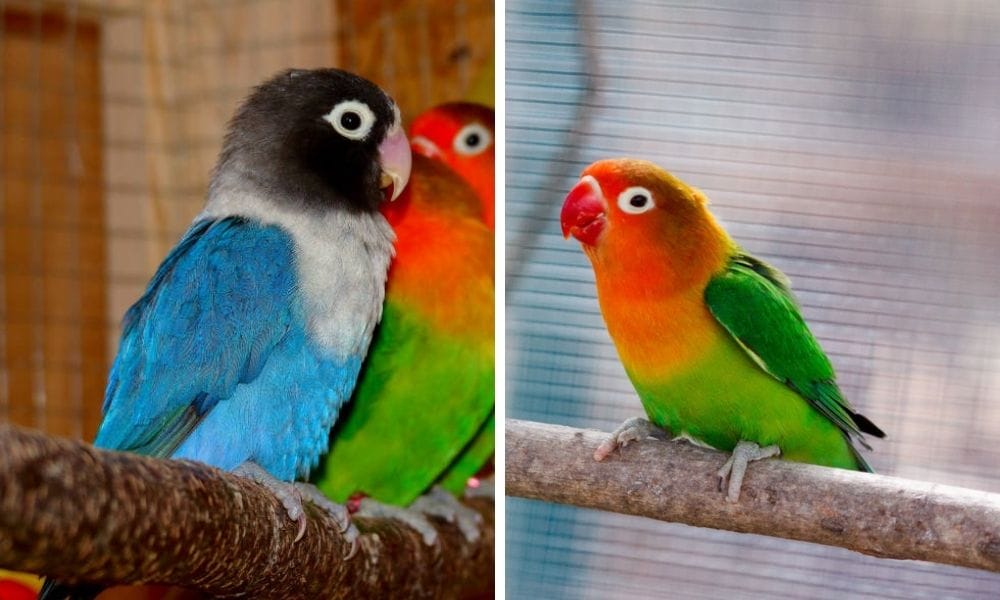
Fresh Fruits and Vegetables
Fresh fruits and vegetables should be a staple in a lovebird's diet. Fruits like apples, pears, and berries provide essential vitamins, while vegetables like carrots, broccoli, and leafy greens offer vital minerals. These foods should be washed thoroughly and cut into small pieces to make them easier for the lovebirds to eat.
Offering a variety of fresh fruits and vegetables can help prevent boredom and encourage healthy eating habits. It's essential to introduce new foods gradually and observe how your lovebird reacts to them. Some birds may be hesitant to try new foods, but with patience and persistence, they can learn to enjoy a varied diet.
The Importance of Fresh Water
Fresh water is essential for a lovebird’s health. Water dishes should be cleaned and refilled daily to ensure that the water remains fresh and free from contaminants. Lovebirds drink frequently and require constant access to clean water. Lovebirds can be messy, so it’s crucial to monitor their water dishes and clean them regularly.
Providing fresh water also helps prevent dehydration, which can lead to severe health issues. In addition to water dishes, some lovebird owners use water bottles designed for birds to keep the water clean and reduce spillage. Ensuring that your lovebird has access to fresh water at all times is vital for their well-being.
The Role of Pelleted Foods
Pelleted foods play a significant role in a lovebird's diet. These foods are formulated to provide all the essential nutrients that lovebirds need to stay healthy. Unlike seeds, which can be high in fat and low in nutrients, pelleted foods offer a balanced diet.
Introducing pelleted foods to a lovebird's diet can be challenging, especially if they are used to eating seeds. Gradually mixing pellets with seeds and offering them alongside fresh foods can help with the transition. Consulting with an avian veterinarian can also provide guidance on the best pelleted foods for your lovebird.
Common Health Problems Related to Diet
Poor nutrition can lead to various health problems in lovebirds. Obesity, for example, is a common issue caused by a diet high in seeds and low in fresh foods. Obesity can lead to other health problems, such as fatty liver disease and heart issues.
Vitamin deficiencies are another concern, especially if the diet lacks fresh fruits and vegetables. A lack of vitamin A, for example, can lead to respiratory issues and weakened immune systems. Watch for symptoms such as tail bobbing and runny nose, as these can indicate underlying health issues related to poor diet. Regular check-ups with an avian veterinarian can help identify and address any nutritional deficiencies.
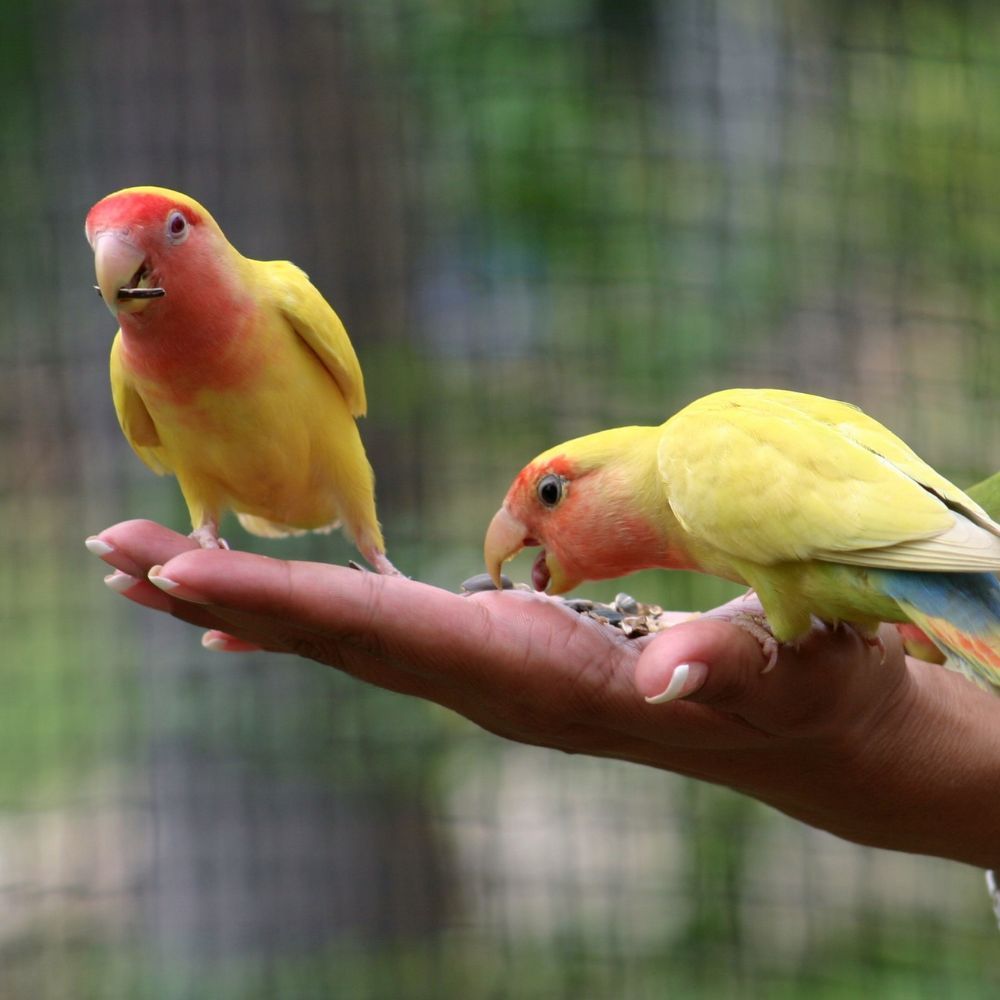
The Benefits of a Varied Diet
A varied diet is essential for a lovebird's health and well-being. Offering a mix of seeds, pelleted foods, fresh fruits, and vegetables ensures that they receive all the necessary nutrients. A varied diet also helps prevent boredom and encourages natural foraging behaviors.
Lovebirds are curious and intelligent birds that enjoy exploring different foods. Providing a variety of food items can stimulate their minds and keep them engaged. It's essential to continually strive to offer new and different foods to keep their diet interesting and nutritious.
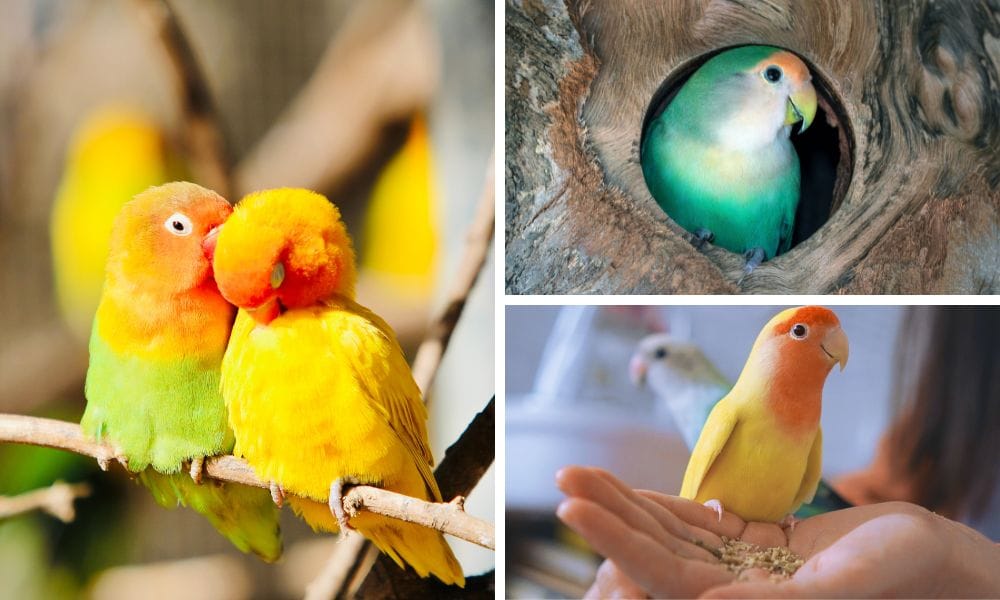
The Role of Treats in a Lovebird's Diet
Treats can be a fun and rewarding part of a lovebird’s diet, but they should be given in moderation. Treats like millet spray and honey sticks are high in sugar and fat and should not replace their regular diet. Instead, use treats as a way to bond with your lovebird and encourage positive behaviors.
Offering treats during training sessions or as a reward for good behavior can help strengthen the bond between you and your lovebird. It’s essential to choose healthy treats and avoid overfeeding to prevent obesity and other health issues.
Treats can also include enrichment items like shiny objects, such as mirrors or metal toys, which lovebirds enjoy playing with for mental stimulation and happiness.
Socialization and Interaction
Lovebirds are renowned for their affectionate and interactive nature. As highly social birds, they flourish with regular attention and companionship. Bonded pairs constantly groom each other, reinforcing their close relationship and keeping their feathers in top condition. To nurture this social side, spend time with your lovebirds every day—whether it’s through gentle hand feeding, playing with toys together, or simply sitting nearby and talking to them in a calm voice. If you keep a single bird, be aware that it will need extra social interaction from you to ensure its happiness and well-being, as lovebirds naturally thrive in pairs.
Slow, gentle movements are best, as sudden actions can startle these sensitive birds. Fischer’s lovebirds, in particular, are known for their playful and loving personalities, making them ideal for owners who want to form a deep bond with their pets. A tame lovebird is more likely to bond closely with its owner and may even learn to say a few words, though lovebirds are not known for extensive talking. Regular interaction not only keeps your lovebirds tame and happy but also helps prevent behavioral issues that can arise from loneliness or boredom. Remember, a well-socialized lovebird is a joyful and affectionate companion.
Exercise and Play
Lovebirds are active birds that need daily opportunities for exercise and play to stay healthy and content. Providing a variety of toys—such as seed bells, swings, ladders, and chew toys—encourages natural behaviors like climbing, gnawing, and exploring. These activities help prevent boredom and support both physical and mental well-being.
In addition to toys, make sure your lovebirds have space to fly and stretch their wings within their cage. A bathing dish or shallow water dish is also a great addition, as many lovebirds love to splash and play in the water. During bath time, they often dip their heads and upper bodies in the water while perched on the edge of the dish. Spraying your lovebirds with a light mist of lukewarm water is another gentle and effective way to help them bathe and stay clean, without fully submerging them. This helps keep their feathers clean and their minds stimulated. Rotate toys regularly and introduce new challenges to keep your birds engaged. By offering a balanced mix of exercise, play, and enrichment, you’ll help your lovebirds lead a vibrant, active life.
Grooming and Hygiene
Maintaining good grooming and hygiene is essential for your lovebirds’ health. Regularly clean the cage, perches, and all food and water dishes to prevent the buildup of bacteria and reduce the risk of internal parasites. A balanced diet rich in essential nutrients, including calcium and vitamin supplements, supports feather health and helps prevent issues like feather disease.
Fischer's Lovebird is known for its vibrant plumage and requires regular grooming to maintain feather quality. Fischer's Lovebirds, as a species, benefit from social grooming and interaction to stay healthy and happy. Single lovebirds may require extra attention and grooming, as they can become stressed or bored without a companion. Monitor your birds for signs of illness, such as excessive scratching, odd breathing, or changes in droppings, and consult an avian veterinarian promptly if you notice anything unusual. Routine check-ups with an avian veterinarian are invaluable for early detection of health problems and ensuring your lovebirds receive the best possible care. By prioritizing cleanliness, nutrition, and regular health checks, you’ll help your lovebirds thrive for years to come.
Common Behavioral Issues
Even the most charming lovebirds can develop behavioral issues if their needs aren’t fully met. Some common challenges include excessive screaming, feather plucking, and occasional aggression. These behaviors often stem from boredom, lack of social interaction, or an unbalanced diet. To help prevent and address these issues, make sure your lovebird’s environment is stimulating, with plenty of birds perch options, toys, and opportunities for exercise. Regular out-of-cage time and positive interaction with you or other birds can also make a big difference. Providing a balanced diet rich in essential nutrients supports both physical and mental health, reducing the likelihood of stress-related behaviors. By understanding your lovebird’s needs and responding proactively, you can help your pet bird lead a happy, well-adjusted life.
Tips for New Bird Owners
Starting your journey as a new bird owner can feel daunting, but a few simple steps can set you and your lovebird up for success. First, focus on providing a balanced diet that includes a variety of fresh fruits, vegetables, and grains to meet your bird’s nutritional needs. Make sure your lovebird always has access to clean, fresh water and a tidy living space, with food and water dishes cleaned daily. Spend quality time with your bird each day—whether it’s through gentle play, training, or simply talking to them—to build trust and encourage socialization. Establishing a consistent routine for feeding, exercise, and sleep will help your lovebird feel secure and develop healthy habits. Don’t hesitate to seek advice from experienced bird owners or consult an avian veterinarian for guidance as you learn. With patience and care, you’ll create a loving, enriching environment where your lovebird can truly thrive.
Advanced Bird Care
For those looking to elevate their lovebird care, advanced techniques can make a significant difference in your bird’s health and happiness. Start by diversifying your lovebird’s diet with fresh greens and various garden herbs such as parsley, basil, and dill, which provide extra nutrients and enrichment. Incorporating natural elements like tree branches into the cage not only offers additional birds perch options but also encourages natural foraging and chewing behaviors, keeping your lovebird mentally and physically stimulated. Stay informed about the latest research and best practices in avian care, and consider rotating toys and perches to keep your bird’s environment engaging. Whether you’re interested in breeding, showing, or simply deepening your bond with your pet, these advanced care strategies will help ensure your lovebird enjoys a vibrant, fulfilling life.
Consulting with an Avian Veterinarian
Regular consultation with an avian veterinarian is crucial for maintaining a lovebird's health. An avian vet can provide guidance on the best diet for your lovebird and help identify any nutritional deficiencies. They can also recommend specific vitamins and supplements if needed.
Regular check-ups with an avian veterinarian can help catch any health issues early and ensure that your lovebird's diet meets all their nutritional needs. It's essential to build a relationship with a trusted avian vet and seek their advice on any dietary concerns.
Summary
Caring for lovebirds involves providing a varied and nutritious diet that includes seeds, pelleted foods, fresh fruits, and vegetables. Proper food and water dishes, regular consultation with an avian veterinarian, and offering healthy treats are all essential aspects of lovebird care. By understanding and meeting their dietary needs, you can ensure that your lovebirds stay healthy, happy, and full of life.
FAQ
What foods should I avoid feeding my lovebird?
Avoid feeding your lovebird avocado, chocolate, caffeine, and alcoholic beverages, as these can be toxic. Also, steer clear of junk food and foods high in sugar and fat.
How can I convert my seed-eating lovebird to a pelleted diet?
Gradually mix pelleted foods with seeds, slowly increasing the amount of pellets over time. Offering fresh fruits and vegetables can also help in the transition.
How often should I clean my lovebird's food and water dishes?
Food and water dishes should be cleaned daily to prevent the growth of bacteria and mold. This daily cleaning is an essential part of basic cage care to ensure a healthy environment for your lovebird. Fresh water should be provided daily, and food dishes should be washed regularly to maintain hygiene.
If you are looking for the top-rated food for your lovebird, look no further. Click the link below to view a selection of only the best birdseed! Here you will find food items of only the highest quality, all with great reviews from people who have already purchased them. Plus, you get to take advantage of special discounts and free shipping options. Don’t delay; visit the link now and see what amazing products await you! Your lovebird will thank you later.

